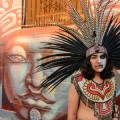A Union Pacific truck—riding the railroad tracks on specialized train wheels—stops just past the corner of Sixth and Empire streets, in front of a huge in-progress mural, and gives an obligatory warning before squeaking on.
“I’ve never seen that guy before,” says Juan Carlos Araujo, owner of Empire Seven Studios and the catalyst for what is now one of the largest murals in San Jose.
Empire Seven is only a few hundred feet away, so Araujo is familiar with the Union Pacific workers, whom he has met while overseeing the painting of the many murals along the tracks.
Today he is watching as L.A.-based artist and muralist Andrew Schoultz works on a large, complex piece of art, which covers a wall two stories tall and 50 yards wide. A veteran of the public art world, and a resident of San Francisco for nearly two decades, Schoultz knows the work it takes to complete a piece like this.
“It’s like an extreme sport”, Schoutlz says, reflecting on the process of covering 36,000 square feet in paint. To fully realize the mural, Schoutlz and a team of four people—including Araujo—working for five straight days, using everything from exterior house paint to boutique European spray paint.
The mural itself is an expansive and vibrant allegory for the water shortages that have hit California in recent years. On one side, a giant vase tips water, petals and tendrils across a long rectangular gradient that holds a large, mongoose-like creature. With juxtaposing styles, soft color gradients and forced perspective, the mural is both linear and detached by the section.
In the same way that the seriousness of the water issue is swept under the political rug, the painting depicts droplets of water smothered by large tendrils and geometric bundles. The emphasis of the figures and shapes are reinforced by a color gradient—white on the periphery and fading to a solid black strip, which runs the length of center of the piece.
Schoultz’s painting is the most recent piece of public art funded by the E7S Mural Project—which has aided in the creation of large works all over the city, but particularly in Japantown. Through the support of organizations, such as the Knight Foundation, and the persistence of Araujo and Empire Seven Studios, there are now more than 60 pieces of public art in Japantown, and Araujo, for one, couldn’t be happier about it. “It is a treat to have this in San Jose,” he says.

 The Best Date Spots, Even if the Person You're with Kind of Sucks
The Best Date Spots, Even if the Person You're with Kind of Sucks  Former Wrestler Mick Foley Brings Punchlines Instead of Punches to Improv
Former Wrestler Mick Foley Brings Punchlines Instead of Punches to Improv 

